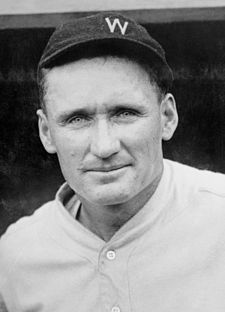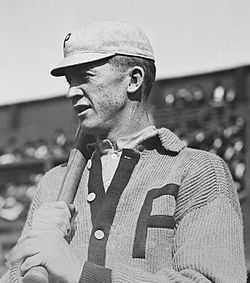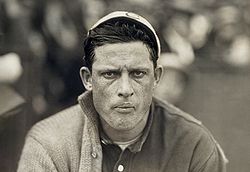- Shutouts in baseball
-
In Major League Baseball, a shutout (denoted statistically as ShO or SHO[1]) refers to the act by which a single pitcher pitches a complete game and does not allow the opposing team to score a run. If two or more pitchers combine to complete this act, no pitcher is awarded a shutout, although the team itself can be said to have “shutout” the opposing team.
The ultimate single achievement among pitchers is a perfect game, which has been accomplished 20 times in over 135 years. By definition, a perfect game is counted as a shutout. A no-hitter completed by one pitcher is also a shutout unless the opposing team manages to score through a series of errors or base on balls. The all-time career leader in shutouts is Walter Johnson, who pitched for the Washington Senators from 1907–1927. He accumulated 110 shutouts,[2] which is 20 more than the second place leader, Pete Alexander.[3] The most shutouts recorded in one season was 16, which was a feat accomplished by both Pete Alexander (1916) and George Bradley (1876).[4] These records are considered among the most secure records in baseball, because pitchers today rarely earn more than one or two shutouts per season with a heavy emphasis on pitch count and relief pitching. Complete games themselves have also become rare among starting pitchers. The current active leader in shutouts is Roy Halladay of the Philadelphia Phillies. Pitching in his fourteenth season, he has accumulated 19 shutouts, which ranks him as tied for 270th among the all-time leaders in shutouts.[5][6]
Contents
Overview
A shutout is officially defined by Major League Baseball rule 10.18:
“ A shutout is a statistic credited to a pitcher who allows no runs in a game. No pitcher shall be credited with pitching a shutout unless he pitches the complete game, or unless he enters the game with none out before the opposing team has scored in the first inning, puts out the side without a run scoring and pitches the rest of the game without allowing a run. When two or more pitchers combine to pitch a shutout, the league statistician shall make a notation to that effect in the league's official pitching records.[7] ” A shutout is denoted as a baseball statistic using the abbreviation ShO or SHO. The three-letter abbreviation is used to distinguish it from a strikeout, which uses the abbreviation SO or sometimes K.[8] To achieve a shutout, a pitcher must pitch a complete game without allowing the other team to score a run. However, there are exceptions and other stipulations to this rule.
Jim Creighton of the Excelsior of Brooklyn club is widely regarded to have thrown the first official shutout in history on November 8, 1860.[9] In the National League's inaugural season of 1876, the eight teams played between 59–70 games, but it was common for each team to only have one pitcher on the team who pitched every inning of every game. For that reason, George Bradley pitched 16 shutouts in 1876, which still stands as the Major League record (currently tied with Pete Alexander who pitched the same number in 1916). Bradley's 16 shutouts in one year were almost half the total number he pitched in his nine year career as a pitcher.[10] From 1876–1916, 10 shutouts or more a season was recorded 19 times. With the increase in power hitting and the live-ball era, games saw in increase in runs and decline in shutouts. Since 1917, 10 or more shutouts a season has only been achieved 10 times by pitchers with very exceptional seasons. Jim Palmer was the last American League pitcher to achieve this mark with 10 in 1975, and John Tudor was the last National League pitcher with 10 in 1986.[4]
In 1968 for the Los Angeles Dodgers, Don Drysdale pitched a Major League record six consecutive shutouts on his way to a total of eight. While his statistics that year are often overlooked when compared to fellow National League pitcher Bob Gibson, Drysdale did pitch a then-record 58⅔ consecutive scoreless innings pitched over the course of a month, whereby he did not allow an opposing run. He can be said to have “shutout” the opposition for 58⅔ consecutive innings pitched.[11] That scoreless streak would later be broken by Dodgers pitcher Orel Hershiser in 1988, who pitched one more out than Drysdale to record 59 consecutive shutout innings.[12] Ed Reulbach of the Chicago Cubs is the only pitcher in Major League Baseball history to have pitched two shutouts on the same day. On September 26, 1908, the Cubs played a doubleheader against the Brooklyn Dodgers. Reulbach pitched both games to completion, in which the Dodgers failed to score in both games.[13]
Recording a shutout without starting or pitching a complete game
 Ernie Shore (on the right next to Babe Ruth) is the only pitcher in history to earn a shutout without starting the game or pitching a complete game.
Ernie Shore (on the right next to Babe Ruth) is the only pitcher in history to earn a shutout without starting the game or pitching a complete game.
It is possible for a pitcher to record a shutout without starting the game or pitching a complete game, so long as all the outs in the game are recorded under the same pitcher with no opposing runs scored by the other team. A pitcher who begins the game is recorded as the starting pitcher, regardless of how long that pitcher pitches in the game. A pitcher must face at least one batter before being removed to be considered the starting pitcher and get recorded with the game started, whether the batter faced reached base or was put out in any way.
If the starting pitcher is removed from the game prior to the first recorded out by the opposing team, the pitcher that replaces him can still be eligible for a shutout if the game ends with the opposing team failing to score a run. However, the replacement pitcher cannot be credited with a game started or complete game. In addition to that, the replacement pitcher must complete the rest of the game without being taken out himself for another pitcher at any time during the game. This bizarre scenario leading to an eventual shutout has occurred only once in recorded history. On June 23, 1917, Babe Ruth of the Boston Red Sox walked the first batter of the Washington Senators, Ray Morgan, in the bottom of the first inning. Ruth engaged in an argument with home plate umpire Brick Owens, whereby Ruth was ejected and escorted off the field. Ruth's replacement, Ernie Shore, proceeded to finish the game without allowing the Senators to score. In fact, Morgan was caught stealing, and Shore retired the next 26 batters in a row to complete a perfect game. The game was regarded as a perfect game for many years until it was officially downgraded to a no-hitter since another pitcher took part in the game. Shore and Ruth were credited with a combined no-hitter, even though Ruth pitched unsuccessfully to only one batter in the game. Shore was credited with a shutout for his effort, despite not starting the game or pitching a complete game. However, if Ruth had conceded a run in the first inning without recording an out, such as allowing consecutive walks or hits, Shore would not be able to record a shutout since the other team had scored a run.[14][15]
Games lasting shorter or longer than nine innings
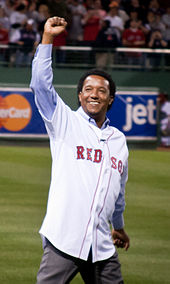 On June 3, 1995, Pedro Martínez pitched nine scoreless innings but did not record a shutout. The game went to extra innings, and Martínez lost his shutout opportunity when he was replaced in the 10th inning.
On June 3, 1995, Pedro Martínez pitched nine scoreless innings but did not record a shutout. The game went to extra innings, and Martínez lost his shutout opportunity when he was replaced in the 10th inning.
A shutout must fall under the technical definitions of a complete game, which consists of only one pitcher pitching an entire game, regardless of how long the game lasts. However, the complete game stipulation is waived if the same pitcher manages to record every single out in the game without having technically started the game, as noted above with the game pitched by Ernie Shore. A standard Major League Baseball game consists of nine innings, unless weather or other uncontrollable elements prevent the game from being completed. If five or more innings have been played and the game cannot be resumed in a timely manner under normal conditions, it can be ruled as a “complete game” according Major League Baseball rule 4.10.[16] In this case, it is possible for a pitcher to complete only five innings pitched and still be credited with a complete game shutout if the other team fails to score by the time the game is ended. However, no-hitter and perfect game bids are not official unless the game lasts at least nine innings. A shortened game cannot be considered a no-hitter or perfect game, but it can be counted as a shutout if applicable.[17]
Conversely, if a game goes into scoreless extra innings, the same pitcher must pitch until the end of the game, despite having already pitched a full nine innings without allowing a run. If the pitcher is replaced or allows a run during an extra inning, he cannot receive a shutout. This situation is very rare today, because starting pitchers will rarely pitch into extra innings. On June 3, 1995, Pedro Martínez of the Montreal Expos had a perfect game shutout through nine innings against the San Diego Padres. The Expos failed to score as well, and the game was forced into extra innings. The Expos scored a run in the top of the 10th inning. In the bottom of the same inning, Martínez gave up a leadoff double to Bip Roberts to breakup the perfect game and no-hitter. Martínez was immediately replaced by Mel Rojas, who retired the next three batters to end the game. Martínez was credited as the winning pitcher in a 1-0 Expos victory, but he did not record a complete game or a shutout for his efforts since another pitcher had taken part in the game.[18]
No-hitters that are not shutouts
See also: No-hitter and List of Major League Baseball no-hittersIn the majority of cases, a no-hitter is also recorded as a shutout if it is performed by a single pitcher pitching a complete game. If a no-hitter is achieved with more than one pitcher, no pitcher is awarded a shutout or a no-hitter, but a team shutout and no-hitter is still acknowledged. It is possible under rare circumstances for a no-hitter to not be a shutout (either individually or a combined effort). If the opposing team manages to score through a series of errors, sacrifice flies, hit batsman, or base on balls, then the no-hitter remains intact while the shutout is lost. Since 1875, there have been 271 recorded no-hitters, and the vast majority of these have been completed by a single pitcher. Of that number, 24 instances resulted in a no-hitter that was not a shutout since the other team managed to score without actually getting a hit. Of these, there have only been two instances where the team that achieved no hits in the game actually won. One of these games was a combined no-hitter loss accomplished by more than one pitcher, and there has only been one recorded instance in history where a single pitcher lost a complete game no-hitter.
On April 23, 1964, Ken Johnson of the Houston Colt .45s was beaten 1-0 by the Cincinnati Reds. Johnson had a no-hitter and shutout going into the last inning, but his team also failed to score by that point. The winning run for the Reds was scored by Pete Rose in the top of the ninth inning. Rose hit the ball weakly right back to the pitcher, but Johnson committed a throwing error that allowed Rose to reach second base without actually recording a hit. He reached third base on a ground out and soon after went onto score on a second error — a wild pitch — committed by Johnson. The Colt .45s lost the game with Johnson taking the loss, even though his no-hitter remained intact. It is the only recorded instance where a pitcher lost a complete game no-hitter.[19] The only other instance of a lost no-hitter occurred when the Baltimore Orioles lost to the Detroit Tigers by a score of 2-1 on April 30, 1967. While the Tigers recorded no hits during this game and still won, the Orioles used more than one pitcher, therefore eliminating an individual shutout opportunity.[20]
For games that were shortened due to weather or darkness, a shutout can still be recording by a single pitcher, but under Major League Baseball's official definition of a no-hitter, a no-hitter cannot be achieved unless the game lasts nine innings.[17][21]
Team shutouts
If two or more pitchers combine to throw a shutout, no pitcher is credited individually with a shutout, but the team as a whole can be said to have “shutout” the other team. The record for the most consecutive shutouts by a single team is held by the Pittsburgh Pirates, who recorded six consecutive shutouts in 1903. That team also holds the record for most consecutive scoreless innings pitched with 56. The Chicago Cubs hold the record for the most shutouts achieved in a single season with 32 — a remarkable feat they accomplished in both 1907 and 1909. The 1908 St. Louis Cardinals hold the dubious record of being shutout 33 times in one season. Only five teams in Major League Baseball history have gone an entire season without recording a single shutout. In 1898, three teams — the Brooklyn Bridegrooms, St. Louis Browns, and Washington Senators — failed to defeat a team all season without allowing a run. The infamous 1899 Cleveland Spiders also achieved this dubious record. The only team since then do so was the expansion 1993 Colorado Rockies.[13] That year, the Rockies had a record of 67-95, in which they never shutout their opponents in any of their 67 wins.[22]
The largest margin of victory in a “shutout” game is held by the Providence Grays, who defeated the Philadelphia Quakers 28-0 on August 21, 1883. The largest shutout margin of victory in recent times was 22-0 when the Cleveland Indians defeated the New York Yankees on August 31, 2004.[13]
League leaders
Main article: List of Major League Baseball shutout champions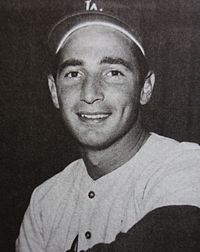 Los Angeles Dodgers pitcher Sandy Koufax led the National League with 11 shutouts and also captured the league's Most Valuable Player and Cy Young Award in 1963. His 11 shutouts are also the single-season record by any left-handed pitcher.
Los Angeles Dodgers pitcher Sandy Koufax led the National League with 11 shutouts and also captured the league's Most Valuable Player and Cy Young Award in 1963. His 11 shutouts are also the single-season record by any left-handed pitcher.
The pitcher who has the most shutouts at the end of the season is recognized as the league leader in that statistic. The National League and American League both have their own league leaders. A pitcher that leads the league in shutouts is often regarded as one of the best pitchers in the league. Such an accomplishment often makes that pitcher a contender for the Cy Young Award or even rarer as the league's Most Valuable Player, because a high number of shutouts may yield a high number of wins and a low earned run average.
Since the establishment of the MVP Award in 1933, each league elects their own MVP, in which 11 American League pitchers and nine National League pitchers have captured their respective league's highest individual award. The following American League pitchers have led the league in shutouts and captured the MVP Award: Lefty Grove (1931), Spud Chandler (1943), Hal Newhouser (1945), and Vida Blue (1971). The following National League pitchers have also led the league in shutouts and captured the MVP award: Dizzy Dean (1934), Mort Cooper (1942), Sandy Koufax (1963), Carl Hubbell (1933), and Bob Gibson (1968).[23] Established in 1956, the Cy Young Award was only awarded to one pitcher in Major League Baseball; separate awards were given to the American and National League starting in 1967. Since the award was established, there have been 25 times (out of a total of 97 awards given since 1956) where the award was given to a pitcher who also led the league in shutouts.[23] Since the establishment of the Rookie of the Year Award in 1947, three pitchers have led the league in shutouts in their rookie year and also captured the Rookie of the Year Award: Don Newcombe (1949), Fernando Valenzuela (1981), and Hideo Nomo (1995).[24] Only 16 pitchers in the history of the American and National League have led the league in shutouts in their rookie season; only two of these came from the American League.
Walter Johnson, Pete Alexander, and Cy Young each hold the record for having led the league in shutouts on seven different occasions. They are ranked first, second, and fourth respectively on the list of career shutouts. More recently, Roger Clemens led the league six times. Pete Alexander and George Bradley hold the single season shutout record with 16 — a record that is unlikely to ever be broken. 27 pitchers on 29 occasions have accumulated 10 or more shutouts in a single season, while Ed Walsh and Pete Alexander are the only pitchers to have achieved 10 or more on two separate occasions. Of those 29, only three of these occasions were not high enough to lead the league. In the National League in 1884, Jim McCormick and George Radbourn had 10 and 11 shutouts respectively, while Pud Galvin had 12. Also, in the American Association in 1886, Dave Foutz had 11 shutouts but came second to the 12 by Ed Morris.[25]
With the decline in shutouts, since 1999, only three pitchers — A. J. Burnett, Dontrelle Willis, and CC Sabathia — have achieved five shutouts in a single season, although Sabathia's five shutouts are a combined total from having played in both leagues in one season. CC Sabathia is the only player in history to have led both leagues in shutouts in the same year when he did so in 2008. He had two shutouts for the Cleveland Indians of the American League when he was traded in the middle of the season to the Milwaukee Brewers of the National League. He accumulated three shutouts with the Brewers to lead the league. His two shutouts in the American League would also lead the league at the end of the year, even though he was in a different league at the time.[25] Recently, accumulating only 2–3 shutouts may qualify a pitcher to lead or tie the league lead in shutouts.[25]
Top 50 career leaders
-
Denotes a member of the Baseball Hall of Fame
Rank Player Career Shutouts 1 Walter Johnson 1907–1927 110 2 Pete Alexander 1911–1930 90 3 Christy Mathewson 1900–1916 79 4 Cy Young 1890–1911 76 5 Eddie Plank 1901–1917 69 6 Warren Spahn 1942–1965 63 7 Nolan Ryan 1966–1993 61 Tom Seaver 1967–1986 9 Bert Blyleven 1970–1992 60 10 Don Sutton 1966–1988 58 11 Pud Galvin 1875–1892 57 Ed Walsh 1904–1917 13 Bob Gibson 1959–1975 56 14 Mordecai Brown 1903–1916 55 Steve Carlton 1965–1988 16 Jim Palmer 1965–1984 53 Gaylord Perry 1962–1983 18 Juan Marichal 1960–1975 52 19 Rube Waddell 1897–1910 50 Vic Willis 1898–1910 21 Don Drysdale 1956–1969 49 Ferguson Jenkins 1965–1983 Luis Tiant 1964–1982 Early Wynn 1939–1963 25 Kid Nichols 1890–1906 48 Rank Player Career Shutouts 26 Roger Clemens 1984–2007 46 Tommy John 1963–1989 Jack Powell 1897–1912 29 Whitey Ford 1950–1967 45 Addie Joss 1902–1910 Phil Niekro 1964–1987 Robin Roberts 1948–1966 Red Ruffing 1924–1947 Doc White 1901–1913 35 Babe Adams 1906–1926 44 Bob Feller 1936–1956 37 Milt Pappas 1957–1973 43 38 Tommy Bond 1874–1884 42 Catfish Hunter 1965–1979 Bucky Walters 1931–1950 41 Mickey Lolich 1963–1979 41 Hippo Vaughn 1908–1921 Mickey Welch 1880–1892 44 Chief Bender 1903–1925 40 Jim Bunning 1955–1971 Larry French 1929–1942 Sandy Koufax 1955–1966 Claude Osteen 1957–1975 Ed Reulbach 1905–1917 Mel Stottlemyre 1964–1974 Top active leaders
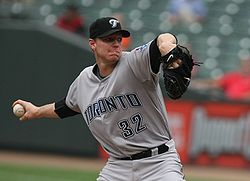 In his 14th season, Philadelphia Phillies pitcher Roy Halladay is currently the active leader in shutouts with 20 — one of which was a perfect game — ranking him 244th on the all-time career list.
In his 14th season, Philadelphia Phillies pitcher Roy Halladay is currently the active leader in shutouts with 20 — one of which was a perfect game — ranking him 244th on the all-time career list.
Rank Player Debut Shutouts 244 Roy Halladay 1998 20 462 Chris Carpenter 1997 13 508 Tim Hudson 1999 12 CC Sabathia 2001 545 Cliff Lee 2002 11 597 Jamie Moyer 1986 10 663 A. J. Burnett 1999 9 Mike Hampton 1993 Liván Hernández 1996 Bartolo Colon 1997 Randy Wolf 1999 742 Mark Buehrle 2000 8 John Lackey 2002 Roy Oswalt 2001 Johan Santana 2000 Brandon Webb 2003 Dontrelle Willis 2003 809 Carl Pavano 1998 7 Javier Vázquez 1998 Pitchers with 10 or more shutouts in one season
Main article: List of Major League Baseball shutout championsPete Alexander (top) and Ed Walsh (bottom) are the only two pitchers in Major League Baseball history to have pitched 10 or more shutouts on two separate occasions.See also
- Baseball statistics
- List of Major League Baseball shutout champions
- No-hitter
- Perfect game
References
- ^ MLB.com (2010). "Baseball Basics: Abbreviations". http://mlb.mlb.com/mlb/official_info/baseball_basics/abbreviations.jsp. Retrieved July 5, 2010.
- ^ Sports Reference LLC (2010). "Walter Johnson at Baseball-Reference.com". http://www.baseball-reference.com/players/j/johnswa01.shtml. Retrieved July 5, 2010.
- ^ Sports Reference LLC (2010). "Pete Alexander at Baseball-Reference.com". http://www.baseball-reference.com/players/a/alexape01.shtml. Retrieved July 5, 2010.
- ^ a b Sports Reference LLC (2010). "Yearly League Leaders & Records for Shutouts". http://www.baseball-reference.com/leaders/SHO_leagues.shtml. Retrieved July 5, 2010.
- ^ MLB.com (2010). "Roy Halladay at MLB.com". http://mlb.mlb.com/team/player.jsp?player_id=136880. Retrieved July 5, 2010.
- ^ Sports Reference LLC (2010). "Career Leaders & Records for Shutouts". http://www.baseball-reference.com/leaders/SHO_career.shtml. Retrieved July 5, 2010.
- ^ MLB.com (2010). "Official Rules: 10.00 The Official Scorer". http://mlb.mlb.com/mlb/official_info/official_rules/official_scorer_10.jsp. Retrieved July 5, 2010.
- ^ MLB.com (2010). "Baseball Basics: Abbreviations". http://mlb.mlb.com/mlb/official_info/baseball_basics/abbreviations.jsp. Retrieved July 5, 2010.
- ^ Thorn, Jim (2009). "The Baseball Biography Project: Jim Creighton". http://bioproj.sabr.org/bioproj.cfm?a=v&bid=770&pid=0. Retrieved July 2, 2011.
- ^ Baseball-Reference (2010). "George Bradley at Baseball-Reference.com". http://www.baseball-reference.com/players/b/bradlge01.shtml. Retrieved August 26, 2010.
- ^ The Baseball Page (2008). "Don Drysdale". http://www.thebaseballpage.com/players/drysddo01.php. Retrieved July 5, 2010.
- ^ BaseballLibrary.com (2006). "Orel Hershiser". http://www.baseballlibrary.com/ballplayers/player.php?name=orel_hershiser_1958. Retrieved July 5, 2010.
- ^ a b c Baseball Almanac (2010). "Shutout Records". http://www.baseball-almanac.com/recbooks/rb_shut1.shtml. Retrieved July 5, 2010.
- ^ ESPN.com (2004). "Major league perfect games". http://sports.espn.go.com/mlb/news/story?id=1804279. Retrieved July 5, 2010.
- ^ Vass, G. (June 1998). “Here Are the 13 Most Fascinating No-Hitters,” Baseball Digest.
- ^ MLB.com (2010). "Official Rules: 4.00 Starting and Ending a Game". http://mlb.mlb.com/mlb/official_info/official_rules/start_end_4.jsp. Retrieved July 5, 2010.
- ^ a b MLB.com (2010). "MLB Miscellany: Rules, regulations and statistics: Perfect games and No-hitters". http://mlb.mlb.com/mlb/official_info/about_mlb/rules_regulations.jsp. Retrieved August 25, 2010.
- ^ Retrosheet (2010). "Montreal Expos 1, San Diego Padres 0". http://www.retrosheet.org/boxesetc/1995/B06030SDN1995.htm. Retrieved July 5, 2010.
- ^ Retrosheet (2010). "Cincinnati Reds 1, Houston Colt .45s 0". http://www.retrosheet.org/boxesetc/1964/B04230HOU1964.htm. Retrieved July 5, 2010.
- ^ Retrosheet (2010). "Detroit Tigers 2, Baltimore Orioles 1 (1)". http://www.retrosheet.org/boxesetc/1967/B04301BAL1967.htm. Retrieved August 25, 2010.
- ^ Baseball Almanac (2010). "American League No Hitters: Less Than Nine Innings". http://www.baseball-almanac.com/pitching/pinohit1.shtml. Retrieved August 25, 2010.
- ^ Baseball Almanac (2010). "1993 Colorado Rockies season". http://www.baseball-almanac.com/teamstats/schedule.php?y=1993&t=COL. Retrieved July 5, 2010.
- ^ a b Sports Reference LLC (2010). "Most Valuable Player MVP Awards & Cy Young Awards Winners". http://www.baseball-reference.com/awards/mvp_cya.shtml. Retrieved August 25, 2010.
- ^ MLB.com (2010). "Rookie of the Year winners". http://mlb.mlb.com/mlb/awards/mlb_awards_content.jsp?content=roy_history. Retrieved August 25, 2010.
- ^ a b c Sports Reference LLC (2010). "Yearly League Leaders & Records for Shutouts". http://www.baseball-reference.com/leaders/SHO_leagues.shtml. Retrieved August 26, 2010.
Baseball statistics Batting Batting average • On-base percentage • Slugging percentage • Hit – (Single • Double • Triple • Home run) • Grand slam • RBI • Game-winning RBI • Bunt • Sacrifice bunt • Sacrifice fly
Baserunning Run • Stolen base • Stolen base percentage • Caught stealing
Pitching Win–loss record • Pitchers of record • Save • Hold • Earned run • ERA • Quality start • Complete game • Shutout • Wild pitch • Passed ball • Strikeout • WHIP
Fielding Sabermetrics Base runs • Extrapolated Runs • Isolated Power • On-base plus slugging • Range factor • Runs created • Secondary average • Out of zone plays made • Ultimate zone rating • Weighted on-base average • Wins above replacement • Win probability added • Win shares
Team stats Sports league ranking
Major League Baseball records Baseball statistics (types of records)General Record holders • Single-game records • Single-season records • Career records • Record breakers by season • Records considered unbreakable
Batting leaders CareerBatting average (.330+) • On-base% (.400+) • Slugging% (.500+) • On-base plus slugging (.900+) • OPS/OPS+ • 3,000 hit club • Hits (2,000+) • Doubles (400+) • Triples (100+) • Home runs (career) • Home runs (top 300) • 500 home run club • RBIs (1,000+) • Total bases (4,000+) • Walks drawn (top 100) • Strikeouts (Top 16 / 1,400+) • Hit records • Home run records • Doubles records • Triples records • RBI records • Consecutive games played • 2,500 games played • 10,000 at-bats
Single seasonTriples (20+) • Home runs (by year) • 50 home run club • RBI (by year) • Batting average (by year) • Single-season home run record
Baserunning leaders CareerRuns (1,000+) • Stolen bases • Stolen base records • Runs records
Single seasonPitching leaders CareerWins • 300 win club • Games started • Games finished • Innings pitched • Strikeouts (top 100) • 3,000 strikeout club • 300 save club • Shutouts • ERA (top 200) • WHIP (top 100) • Walks allowed (top 100) • Hit batsmen (top 100) • Wins records
Single seasonWins (by year) • Saves (by year) • Shutouts (by year) • Strikeouts (by year) • Earned run average (by year)
Managing records Single-game records Four home runs • Hitting for the cycle • No-hitter • Perfect game • Strikeouts • Unassisted triple play • Three strikeouts on nine pitches
Multiple stat clubs Triple Crown • 20–20–20 club • 30–30 club • 40–40 club
Categories:- Baseball statistics
- Baseball pitching
- Baseball terminology
-
Wikimedia Foundation. 2010.

